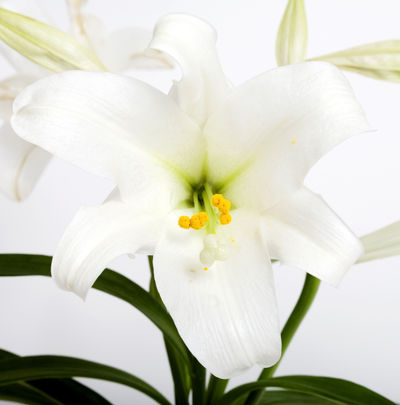Netherland Bulb Company
Known for producing Premium Holland Bulbs 1-800-78-TULIP
Additional Comments from
Rich J. McAvoy of the University of Connecticut
Pot-cooled bulbs are normally potted & held for three weeks at 63F before the six weeks of bulb cooling (at 40-45F). The bulbs then require 14 weeks of greenhouse forcing. This entire process requires 23 weeks from initial potting to Easter. This is the same process used for both naturally cooled or CTF bulbs.
Case-cooled bulbs require six weeks of cooling followed by 17 weeks of greenhouse forcing to flower in time for Easter. Insurance lighting should not be needed this year, but can be used if you can’t complete the full 6-weeks of bulb cooling.
Insurance lighting
Provide insurance lighting if you know or suspect that bulbs have not received the entire six weeks of cooling. Insurance lighting refers to night break lighting used to produce a long day photoperiod. When insurance lighting is used immediately following shoot emergence, it will produce the same effect as bulb cooling or vernalization. Therefore, insurance lighting can be used to substitute for inadequate bulb cooling. Provide one day of insurance lighting for each day of lost cooling. Incandescent, fluorescent, or HID lighting in excess of 10 f.c. from 10 pm to 2 am daily will provide the necessary night break.
Fertigation
Start fertilizing with a soluble formulation when lilies emerge and continue to within 7 days of sale. Combine calcium nitrate (3 parts) with potassium nitrate (2 parts) to make a 15 0 18 soluble fertilize, or use a commercial 15-0-15 formulation. If phosphorus was not added to the medium, 20-10-20 can be used on an alternating basis with a 15-0-15. Fertilizer rates should range from 200-400 ppm. Do not allow medium EC to exceed 3-3.5 mmho/cm based on a Saturated Media Extract. Stop fertilizing just before sale. Provide one clear watering before lilies are shipped - this will reduce salt levels in the potting medium and maximize lily-keeping quality. Do not withhold water or fertilizer to slow development. Do not over water (i.e. water too frequently) or root rot problems may occur.
Decrease Leaf Yellowing & Delay Flower Senescence: To prevent early-season (7 to 10 days before visible bud) & mid-season (7 to 10 days after visible bud) leaf yellowing, spray Fascination at 10/10 ppm. (Note: Fascination contains two active ingredients and recommendations include the concentration of each). Apply only to lower leaves & cover thoroughly. To prevent late-season leaf yellowing and post-harvest flower senescence, spray 100/100 ppm to thoroughly cover all foliage & buds. Apply when buds are 3 to 3 ½” long & NOT MORE than 14 days before shipping or cooling. Protects leaves from yellowing for up to 14 days. Note: Side effects include increased stem stretch. Avoid direct contact of spray to immature leaves during early- & mid-season applications.
Disease and pest control: Before planting, clean bulbs of debris removing any damaged scales, especially scales that show evidence of infection. Once potted, root rots associated with Rhizoctonia, Fusarium, and Pythium are a concern. Drench immediately with Banrot, a broad-spectrum fungicide, or you can treat to control these diseases separately by selecting from the fungicides specifically registered for Rhizoctonia, Fusarium and Pythium control on lily. Materials registered for Rhizoctonia and/or Fusarium include 26GT, 26/36, Contrast ( Rhizoctonia), Sextant, and Terraclor WP ( Rhizoctonia). Materials registered for controlling Pythium include Alude, Banol, Subdue Maxx, Truban WP and Truban EC. Check with manufacturers regarding compatibility when tank mixing fungicides for Pythium with Rhizoctonia/Fusarium controlling materials. Fungicides may need to be re-applied later in the crop; check labels for guidance.
Aphids, fungus gnats, and bulb mites are a major concern. Use only smokes or aerosols once in bud. Many chemicals are listed for aphid control, including, Safari, Celero, Flagship, Tristar, Marathon, DuraGuard, Distance, Enstar II, Preclude TR, Tame, Thiodan smoke, Ultrafine Oil, Insecticidal Soap, Talstar and Endeavor. Fungus gnats can be controlled with many of these same chemicals as well as Citation, Adept, insect parasitic nematodes (Nemasys, NemaShield, Scanmask) and Gnatrol. Bulb mites, Rhizoglyphus robini, represent one of the more troublesome insect pests on lilies. Duraguard is labeled as a drench for soil borne organisms that may include bulb mites. Bulb mites are more likely to attack physically damaged bulbs – so be sure to control fungus gnats and handle bulbs gently.
Note: Registration of pesticides varies by state so consult and follow labels for registered uses. To avoid any potential phytotoxicity or residue problems, spot test first before widespread use. No discrimination is intended for any products not listed.
Controlling Lily Height
Use A-Rest, Chlormequat E-Pro, Concise, Cycocel, Topflor, or Sumagic as needed when shoots are 3-5" tall. Split applications provide the best results. You can apply any of the PGRs at ¼ to ½ normal rate, as needed, to control height. Reduce the concentrations of Sumagic used when combined with DIF. Use DIF, or cool morning DIP, to control lily height. Equal day/night temperatures, high night/low day temperatures or cool morning temperatures will keep lilies short.
Lily Storage
Lilies can be stored for up to 10 days in the dark at 35 45F when buds turn white but before they open. Spray for Botrytis control prior to moving lilies to cold storage. Materials registered for botrytis control on lilies include 26GT, 26/36, Daconil, Exotherm Termil, Sextant, and Protect DF. Follow label directions. Water Easter lilies thoroughly before starting cold storage. After lilies are removed from the cooler, place in a shady location to avoid excessive wilting.

